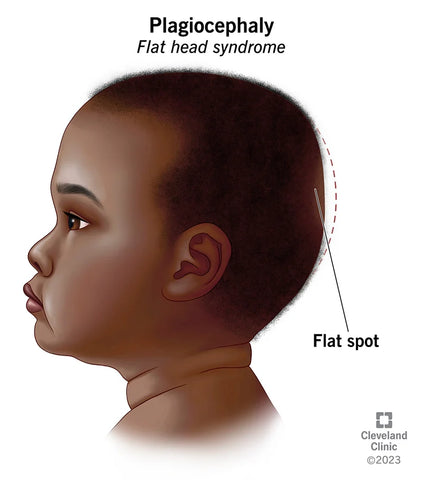When does Flat head Syndrome develop, and can it correct itself?
We are here to review some hot topics we’ve heard from parents. Including When does Flat head Syndrome develop, when does Flat head Syndrome go away, when is Flat Head syndrome diagnosed. We know this is on the top of a lot of your minds so let's dive in.
At what age does Flat Head Syndrome develop?
Flat Head Syndrome or deformational plagiocephaly typically develops in infants during the first few months of life. It is most commonly observed between the ages of 2 to 4 months. During this period, a baby's skull is still soft and malleable, making it more susceptible to changes in shape when there is consistent pressure on one part of the head.
The condition often arises when a baby spends prolonged periods of time lying on their back, which has been recommended to reduce the risk of Sudden Infant Death Syndrome (SIDS). However, this practice can lead to the development of flat spots on the baby's head.
It's important for parents to be aware of this risk and to take measures to prevent Flat Head Syndrome, such as providing supervised tummy time when the baby is awake and ensuring they have opportunities to turn their head in different directions while resting. If a flat spot does develop, early intervention with repositioning techniques or the use of specialized pillows or helmets can help correct the issue. It's advisable to consult with a pediatrician or healthcare provider for guidance on prevention and management if you have concerns about your infant's head shape.

When does Flat Head Syndrome go Away?
Flat Head Syndrome can improve or resolve over time with the right interventions and care. The timeline for improvement or resolution can vary from one infant to another and depends on the severity of the condition and the effectiveness of the chosen treatments. Here are some general points to consider:
- Mild Cases: In milder cases, where the flat spot is not too pronounced, you may notice improvement within a few weeks to a couple of months by following repositioning techniques, encouraging tummy time when the baby is awake, and regularly changing the baby's head position during sleep.
- Moderate Cases: If the condition is more moderate, improvement may take several months with consistent repositioning and other recommended measures.
- Severe Cases: In more severe cases, or if the condition does not improve with repositioning and lifestyle changes, healthcare providers may recommend the use of specialized pillows or helmets. The duration of helmet therapy can vary, but it is typically a few months to several months, depending on the specific circumstances and the severity of the flat spot.
It's crucial to work closely with your pediatrician or a specialist in pediatric craniofacial medicine to monitor your baby's progress and determine the appropriate course of action. They can provide guidance tailored to your child's individual needs and monitor their head shape as they grow. In many cases, with proper care and intervention, Flat Head Syndrome can improve significantly or resolve completely as the baby's head continues to develop and the skull bones harden. Reducing pressure with Crescent Womb can help as well.

When is Flat Head syndrome diagnosed
Positional plagiocephaly can be diagnosed at various stages of a baby's development. Here are some key points regarding when it may be diagnosed:
- During Well-Baby Checkups: Pediatricians often screen for Flat Head Syndrome during routine well-baby checkups, which typically occur within the first few weeks of life and continue at regular intervals throughout the first year. The doctor will assess the baby's head shape, looking for any signs of flattening or irregularities.
- Concerns Noted by Parents: Parents may notice changes in their baby's head shape and raise concerns with their pediatrician. If a parent notices flattening on one side of the baby's head or other irregularities, they should bring it to the attention of their healthcare provider during a well-baby visit or earlier if necessary.
- At Any Age: Flat Head Syndrome can be diagnosed at any age during the infant's first year of life, but it is most commonly identified within the first few months, as this is when the condition typically develops. However, it's important to note that early detection and intervention can be key to addressing the issue effectively.
- Specialized Assessment: In some cases, healthcare providers may refer infants with suspected or diagnosed Flat Head Syndrome to specialists in pediatric craniofacial medicine or physical therapy for a more thorough assessment and guidance on treatment options.
It's essential for parents to be proactive about monitoring their baby's head shape and seeking medical advice if they have any concerns. Early diagnosis and intervention can lead to more successful outcomes in managing and correcting Flat Head Syndrome.
Learn more how Crescent Womb can help prevent Flat Head Syndrome or supplement your current care routine here.


Leave a comment